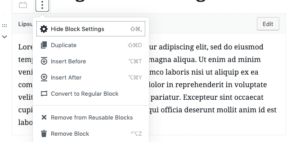Content Writing, Web Design

WordPress functions as a content management system for many law firms. In fact, approximately 33 percent of all websites use it, per data provided by Kinsta. On December 6, 2018, WordPress released Version 5.0, which included the implementation of Gutenberg. This is a block-based editor that may change the way we manage content.
Changes Inputting Content with Gutenberg
Before Gutenberg, WordPress utilized a classic editor that required HTML codes for items such as images. It was straightforward, but very rudimentary. Gutenberg, on the other hand, is much more intricate and allows users more functionality. Post and page building has become dynamic and immersive.
In Gutenberg, you create blocks for specific types of content, layouts, formatting, and more. You can select the type of block you want to input, and move it around on the post or page fluidly. No longer do you have to cut and paste long sections, losing strings of code along the way.
Saving Reusable Blocks with Gutenberg
Another function of Gutenberg is that you can save reusable blocks of text, pictures, and more for future use. This may make sections such as calls to action, testimonials, awards, and results easier to input throughout your website. Although developers can input code that makes these elements a standard section on your pages and posts, Gutenberg allows anyone to input information that can be quickly accessible to users without using code.
Utilizing Gutenberg vs. Classic Editor
Pages and posts that were input before WordPress 5.0 can still get edited in Gutenberg. Their content will be accessible in blocks for editing and movement. However, if you prefer the classic editor, you can still use that as well. A classic editor plugin is available. You’ll still be inputting code and manually moving things as you did before. It can be difficult to maneuver around the classic editor once you become familiar with the fluidity of Gutenberg.
Gutenberg Brings Welcome Change for Dynamic Content
Law firms hoping to create landing pages and blog posts with dynamic content welcome the change that comes with Gutenberg. You can now create rich content with slideshows, background images, and responsive capabilities – all without bringing in a developer to create code for pages. With a little practice, a content professional can create optimal pages with user-centered functions.
Gutenberg Allows Law Firms to Excel at Content Marketing
Gutenberg allows anyone to take control of a web post or page and create dynamic content that is user-friendly. One of the main goals with content marketing is to keep the reader on the page. Now you can create elements such as slideshows, images, and more that will increase interest and prevent the reader from bouncing.
Content professionals no longer have to have in-depth coding knowledge, and developers aren’t needed to add a simple image to a post or page. Instead, a specific block can be selected in Gutenberg to upload an image.
Although the outcome of Gutenberg is similar to that of the classic editor, the function is very different. This can allow a layperson to create more interesting content. With more capabilities, your content can expand beyond a short blog with a logo. Instead, content professionals and people from your firm can create interactive content that guides the reader to contact your firm.
Content Marketing with Gutenberg Through Postali
Postali works to educate law firms about the content marketing process as we create a dynamic website that engages your potential clients. We have extensive web development and design teams that have worked with our content department through the transition from classic editor to Gutenberg. WordPress 5.0 is now being used on some of our newer sites. We will continue to stay up-to-date on the developments in content marketing for law firms. Call us today at 614-556-4618 or use our online form to learn more.

Not sure where to begin?
Get started with a marketing audit.




